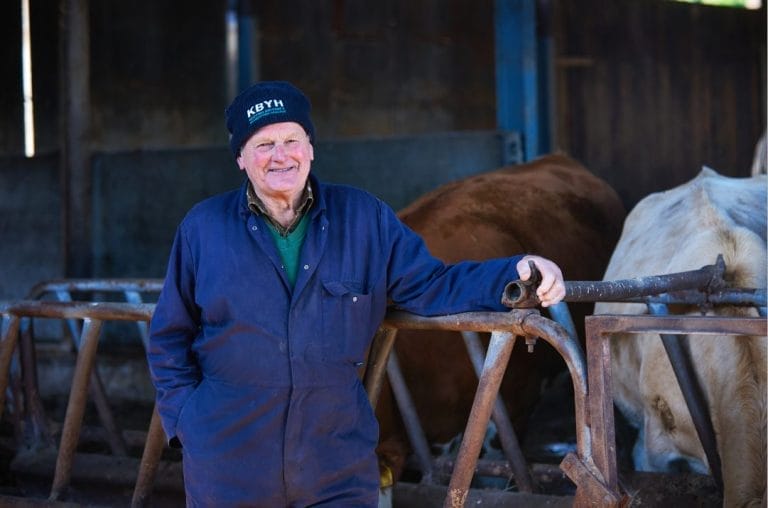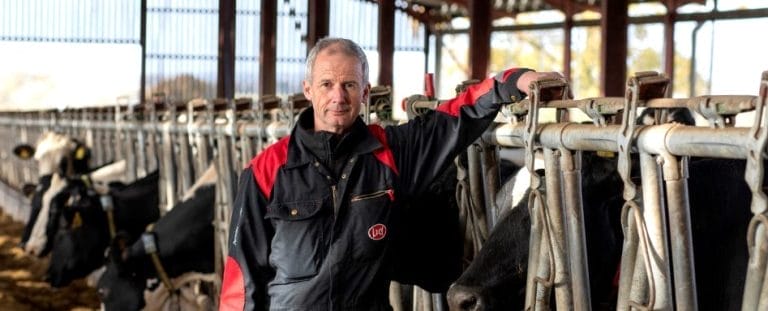
Under-sowing maize with a hybrid ryegrass and red clover ley has delivered multiple benefits for Cornish dairy farmer Chris Sampson.
With five years of the practice under his belt, and now owning his own inter-row drill, Chris is seeing consistent results, and can list extra forage, increased soil carbon and reduced cultivations amongst the key advantages.
Chris is also eligible for a countryside stewardship payment of £172/ha for what is effectively a cover crop, and all of this is achieved with no detriment to his primary goal of growing a high energy maize crop.
“We grow around 40 acres of maize each year, which makes up about half of the winter forage ration for the milking herd,” Chris explains. “We now routinely under-sow it with a grass and clover mix, with the additional stewardship payment more or less paying for the seed. And, with the extra first cut of grass and clover silage we take the following spring, I’d say the whole exercise pays for itself in the first year.”
Maize was first grown at Metha Farm, near Newquay, around 25 years ago, and is now a mainstay of the milking ration for the 112-cow herd of Holstein Friesians. It is grown in rotation with grass and clover leys, with Chris favouring very early varieties that will produce a mature, high-energy crop in a relatively short growing season.
“We’ve tried growing wholecrop cereals as an alternative to maize, but could never achieve the same level of yield,” he adds. “It’s about maximising the energy production and the best measure of that is megajoules per hectare. With the system we now have, we’re able to exploit the full benefits of high energy maize whilst overcoming any environmental concerns with the crop.”
Grass and clover leys at Metha Farm are typically down for three or four years before that land is used for maize. The policy is usually to take a first cut from the old ley in early May before applying farmyard manure and then preparing the ground to drill maize.
“Our oldest leys are often still quite productive, and we’ll top-dress with nitrogen before taking a first cut,” explains Chris. “Once that crop is off, we have a fairly tight turn around to spray off the aftermath and apply muck before ploughing and preparing a seedbed.
“We find the right time to drill maize is at the end of May, or even the first week of June. We’ve tried drilling earlier but it’s usually better to wait until soil temperatures are higher. Even with the relatively late drilling we usually have a crop that hits the target of ‘knee high by the fourth of July’.”
Chris routinely soil samples all of the land going into maize, with the results determining his fertiliser policy for the crop. He may use up to 50kg/acre of DAP in the seedbed, and low level applications of nitrogen and/or MAP, or may decide there’s no requirement at all, adhering strictly to a principle of only applying what is necessary.
Once weeds have been sprayed off, and with the maize crop up to 12 inches high, Chris goes in with his Weaving inter-row drill, sowing a hybrid ryegrass and red clover mix at a regular seed rate of 14kg/acre.
“It’s a disc drill system and the coulters can be set to drill between the rows of maize,” says Chris. “The mix of hybrid ryegrass and red clover works best for our situation. The establishment is effective, so when the maize comes off in the autumn there’s a wispy crop growing underneath that kicks on very quickly.”
The priority for Chris is a mature crop of maize, so he resists the pressures to cut earlier and waits until the cobs are fit. In 2023 the maize came off on 8th October, with an overall fresh weight yield of around 17.5 tonnes/acre at 35.8% dry matter. With winter feeding well underway, the maize was feeding well, contributing a significant proportion to the total mixed ration for cows averaging 7,500 litres per lactation.
THE BENEFITS OF UNDERSOWING MAIZE
With undersowing becoming increasingly popular, Limagrain Maize Sales Manager, Tim Richmond, explains some of the wide-ranging benefits the practice has to offer.
The principal benefit of undersowing maize with a secondary crop such as ryegrass, clover, or vetch, or a combination of all three, is that it prevents maize stubbles from sitting bare over the winter. This not only reduces nutrient losses and soil erosion caused by run-off, but also makes travelling at harvest and in the subsequent spring easier, with the secondary crop helping to improve and bind soil structure.
The undersown crop also provides a valuable winter or spring crop for livestock to graze as well as providing a home for slurry to be spread in the early spring.
Undersowing also helps to improve soil biology, with worm counts typically 6-7 times higher compared to bare maize stubbles.
The secondary crop will also provide competition against spring germinating weeds, and, if conditions turn too wet to drill the next year’s crop, the land will still have a useful grass crop instead of sitting bare for a second winter.
Maize varieties such as Gema, Dignity, Saxon and Skipper are ideally suited for undersowing as they are early maturing which allows the cover crop to become further established after an early maize harvest, yet still go on to deliver a yield on par with the top performing varieties.
To achieve the best levels of cover crop establishment, the secondary crop should be drilled at a rate of around 15kg/ha (depending on the species and mixture) when the maize is at the 4-5 leaf stage. Avoid drilling the cover crop too late as an overly developed maize canopy will prevent the secondary crop from establishing properly, and ensure a gap of 15cm is left between the cover crop and maize drill rows to prevent any detrimental competition effect on maize yields.


































